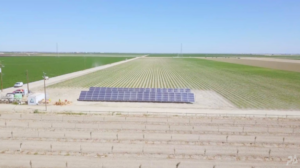Every month, we sift through hundreds of news items and research reports about clean, renewable energy and deliver the best ones directly to your inbox.
New Japanese environment minister touts the end of nuclear power. Although Japanese prime minister Shinzo Abe has stated his desire to restart Japan’s nuclear power plants, the nation’s new environment minister has come out against nuclear energy. Japan shut down its 54 nuclear reactors after the Fukushima disaster in 2011, though plans are in place to put them back in commission to help the country meet its emissions goals. Environment minister Shinjiro Koizumi, on his first day in the position, stated his intentions to decommission the plants entirely rather than put them back online, striking a major blow to the nuclear industry worldwide. (PV Magazine)

Solar and wind have become so cheap, they are no longer as dependent on subsidies. For decades, onshore solar and wind has benefitted from government subsidies to remain competitive in electricity markets. That may no longer be the case. Costs have dropped so low that the quickly disappearing federal subsidies for renewables are no longer necessary for solar and wind to thrive. In an interview with Bloomberg, Microsoft co-founder Bill Gates suggested that these subsidies be passed on to the fledgling technologies that need them, namely offshore wind and storage. (Bloomberg/Yahoo Finance)
LA and 8Minute Solar strike lowest cost solar-plus-storage deal in US history. Los Angeles and 8Minute solar have signed an agreement that will allow the city to produce the cheapest battery-supported solar power in US history. Initially beset by labor disputes, the 2000 acre plant was greenlit for construction and, according to PV Magazine, will supply up to 8% of the city’s energy once built. (Cleantechnica/GreenTech Media)
Gas plants will be crushed by wind and solar by 2035, study says. A report from the Rocky Mountain Institute claims that gas plants will be more expensive to run than battery-supported solar and wind sources within the next two decades. If natural gas will no longer be competitive by 2035, the report adds, any gas plants currently in the works will be obsolete before they are even paid for. (Bloomberg)
Hanwha Q Cells opens largest solar factory in the western hemisphere. A new solar module factory in Georgia, capable of producing over 10,000 modules per day, has officially opened its doors. The 330-345 watt modules will allow the US to decrease its dependence on China for renewable technology and provide panels for solar projects across the country. Hanwha is based in South Korea.
More Headlines
Logic supports renewables, not nuclear
Three Mile Island, home of infamous nuclear accident, is shut down
The oil industry vs. the electric car
The politics of climate change
The Bahamas had microgrids in development before Dorian
Wind developers ordered more turbines in Q2 than ever
White House to relax energy-efficiency standards for light bulbs
Dorian’s savage winds to test mettle of Florida’s solar panels
The biggest batteries coming soon to a grid near you
IKEA is investing $2.8 billion in renewable energy infrastructure
September articles from the Freeing Energy Project
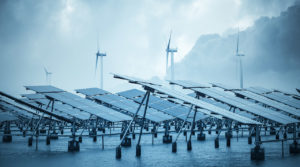 Does the intermittency of solar and wind make electricity more expensive?
Does the intermittency of solar and wind make electricity more expensive?
The intermittency of solar and wind has proven to be a major drawback for renewables. But how much does this intermittency affect prices, and how will it change going forward? (read more)
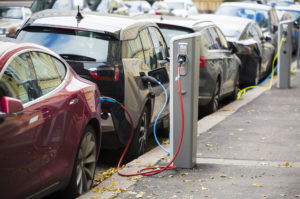 How electric vehicles will transform the grid: Part 1
How electric vehicles will transform the grid: Part 1
As the adoption of electric vehicles grows, our grid will have to adapt in order to power transportation. The benefits of this have the potential to ripple across the entire energy landscape and revitalize a stagnant industry. (read more)
 How electric vehicles will drive over electric monopolies: Part 2
How electric vehicles will drive over electric monopolies: Part 2
Following up on our look at electric vehicles and their effects on the grid, we discuss electricity monopolies and the competition that electric vehicles will introduce into the utility sector. (read more)
Our latest podcasts
Subscribe to follow us on popular podcast platforms:
Podcast #021 – Emily Morris: Can distributed hydropower provide clean local energy 24/7 without expensive dams?
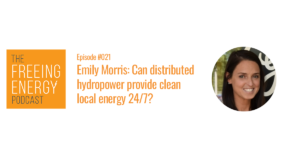
Solar may be the most widely used approach for distributed, renewable electricity generation but emerging new technologies go well beyond solar and offer entirely new ways to generate clean, local energy. Host Bill Nussey talks with Emily Morris, the founder, and CEO of Emrgy, about a radical new approach to hydropower that skips building expensive infrastructure like dams, provides a continuous source of clean local electricity and opens up new revenue streams for customers. It’s called distributed hydro and it’s here now.
Podcast #020 – Alan Russo: Can artificial intelligence turbocharge local energy?
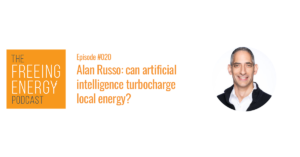
Even as AI software is transforming virtually every industry in the world, the power industry has remained stubbornly analog. But this is about to change. Host Bill Nussey talks with Alan Russo, Chief Revenue Officer for California based STEM. Alan’s company is using AI to transform how energy is stored and consumed and even allows organizations to provide revenue-generating services back to the bigger grid.






